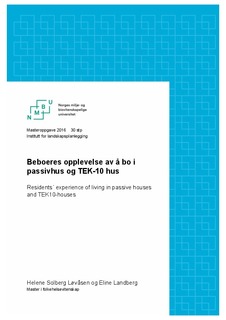| dc.contributor.advisor | Evensen, Katinka Horgen | |
| dc.contributor.advisor | Hauge, Åshild Lappegard | |
| dc.contributor.author | Løvåsen, Helene Solberg | |
| dc.contributor.author | Landberg, Eline Kristina | |
| dc.date.accessioned | 2016-08-26T11:11:07Z | |
| dc.date.available | 2016-08-26T11:11:07Z | |
| dc.date.issued | 2016-08-26 | |
| dc.identifier.uri | http://hdl.handle.net/11250/2402066 | |
| dc.description.abstract | Bakgrunn: Inneklimaforhold i boligen er en viktig helsedeterminant. Byggenæringen og husene vi bor i bidrar til en betydelig del av miljøgassutslippene, som har medført til at energikravene i nye boliger stadig blir strengere. Den norske Regjeringen har vedtatt nye energikrav for boligbygging som skal implementeres i en overgangsperiode på ett år, fra 1. januar 2016 til 1. januar 2017 (revidert TEK10 av 1.1.2016). Passivhus og lavenergihus er byggenæringens svar på energikravene. Med dette ytrer noen helseaktører bekymring for om energikravene for boligbygging går på bekostning av beboeres helse.
Formål: Formålet med studien var å få innblikk i hvordan beboere opplever å bo i passivhus (NS 3700) og hus bygget etter gjeldende byggteknisk forskrift (TEK10), samt hvordan opplevd inneklima kan påvirke helse og trivsel. Opplevde likheter og forskjeller mellom de to boligtypene belyses gjennomgående i teksten.
Metode: Studien har et kvalitativt forskningsdesign, og data ble innsamlet gjennom totalt ti semistrukturerte forskningsintervjuer. Utvalget bestod av tilsammen 15 informanter fra ti husstander, fem intervjuer av beboere i passivhus, og fem intervjuer av beboere i TEK10-hus.
Resultat: Alle beboerne ga uttrykk for at de trivdes i boligen, hvor det viste seg å være flere forhold som spilte inn på den opplevde trivselen. Likevel viste resultatene at beboerne i både passivhusene og TEK10-husene opplevde utfordringer i ulik grad knyttet til inneklima, og brukervennligheten av de tekniske systemene som regulerer inneklimaforhold i boligen.
Konklusjon: Hver enkelt beboers opplevelse av boligforhold, kan spille inn på hvordan boligen påvirker helse og trivsel. Inneklimaets påvirkning på helse og trivsel er individuell, og vil i stor grad avhenge av hvordan en oppfatter omgivelsene sine samt hvor mottakelig en er for stimuli. Beboernes opplevelse av brukervennlighet av de tekniske systemene i boligen, så også ut til å være av betydning for deres helse og trivsel. I tråd med tidligere forskning, viser studien et behov for utvikling av mer brukervennlige tekniske systemer [for varme og ventilasjonsanlegg], for at beboere skal oppleve kontroll og mestring av sin bolig. | nb_NO |
| dc.description.abstract | Background: The indoor climate is an important determinant of health. Since the construction industry and the houses we live in contribute significantly to the environmental gas emissions, the energy reduction requirements for new houses has become increasingly stringent. The Norwegian government has decided new energy requirements for house construction to be implemented during a one-year transitional period up until 1 January 2017. Passive houses and low energy houses are the proposed solutions from the construction industry to meet the new energy requirements. However, some health organizations have pointed out that such technical solutions may have a detrimental effect on health of the residents.
Objective: The objective with this study is to give insight into how residents in passive houses (NS 3700) and houses constructed according to the current tecnical regulations (TEK10) experience their houses, and how experiences of the indoor climate can affect their health and wellbeing. Differences between the residents´ experience with living in houses constructed according to the two different housing standards, are also addressed.
Method: The study has a qualitative research purpose. Data was collected through ten semi-structured interviews. In total 15 residents participated in the interviews representing residents in five passive houses and five TEK10-houses.
Results: All residents expressed their satisfaction with their houses when taking all aspects into consideration. Nevertheless, both residents in passive houses and TEK10-houses experienced different challenges in relation to indoor climate and lack of user friendliness of the technical systems for regulation of the indoor climate.
Conclutions: Each residents´ experience with their housing conditions may influence how the houses affects the health and wellbeing. The influence of the indoor climate on the health and wellbeing of the residents are individual and will to a large extent depend on how the residents view their local environment and their respective receptiveness for stimulus. The residents experience with the technical control systems appears to affect the experienced health and wellbeing. In accordance with previous research, the study shows a need for development of more user-friendly technical control systems [for heating and ventilation systems] in order for the residents to experience control of their residence. | nb_NO |
| dc.language.iso | nob | nb_NO |
| dc.publisher | Norwegian University of Life Sciences, Ås | |
| dc.subject | Bolig | nb_NO |
| dc.subject | Folkehelse | nb_NO |
| dc.subject | Passivhus | nb_NO |
| dc.subject | TEK10-hus | nb_NO |
| dc.subject | Helse | nb_NO |
| dc.subject | Trivsel | nb_NO |
| dc.subject | Inneklima | nb_NO |
| dc.subject | Brukervennlighet | nb_NO |
| dc.subject | Tekniske system | nb_NO |
| dc.subject | Varme- og ventilasjonssystem | nb_NO |
| dc.title | Beboeres opplevelse av å bo i passivhus og TEK10-hus | nb_NO |
| dc.title.alternative | Residents´experience of living in passive houses and TEK10-houses | nb_NO |
| dc.type | Master thesis | nb_NO |
| dc.subject.nsi | VDP::Social science: 200 | nb_NO |
| dc.source.pagenumber | 114 | nb_NO |
| dc.description.localcode | M-FOL | nb_NO |
